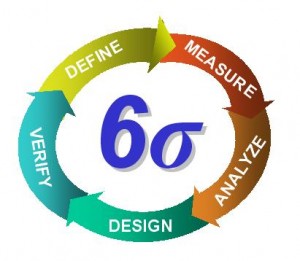 Companies which implement the Six Sigma initiatives in one way or another are called as Six Sigma Companies. Each company implements Six Sigma within its unique scope. One of the aspects of Six Sigma is that it can be adjusted and tailored to meet the needs of the individuals and strategy of a company. This feature has led to various levels of implementation and deployment.
Companies which implement the Six Sigma initiatives in one way or another are called as Six Sigma Companies. Each company implements Six Sigma within its unique scope. One of the aspects of Six Sigma is that it can be adjusted and tailored to meet the needs of the individuals and strategy of a company. This feature has led to various levels of implementation and deployment.
GE has deployed the Six Sigma in a corporate driven top down approach. However not every company has followed the same way. Some companies prefer to carry out smaller projects and then move up for full scale deployment.
Companies have varying deployment scope.
Corporate : In these companies the Six Sigma program is a corporate-wide initiative which is completely supported by the CEO and executive team.
Business Unit : In this case of deployment one or more Business Units are implementing Six Sigma.
Black Belt : This level of deployment refers to a small level of involvement in Six Sigma . To work on projects, they have trained Black Belts or hired a few Black Belts from outside.
Following companies have implemented Six Sigma successfully in one form or the other.
List of Six Sigma Companies
3M, Acme Markets, Advanced Micro Devices, Agilent Technologies, Air Canada, ALCAN, Amazon.com, AXA, Bank of America, Bechtel Corporation, Boeing, CAE Aviation Training, Canada Post, Caterpillar, CIGNA, ,Cognizant Technology Solutions, Computer Sciences Corporation, Cummins Inc., Deere & Company, Dell, Delphi Corporation, Denso, DHL, Dominion Resources, Dow Chemical Company, Dow Chemical Joint Ventures, DSB Bank, DuPont, Eastman Kodak Company, EMC, Flextronics,
Ford Motor Company, General Electric,General Dynamics, Genpact, GlaxoSmithKline, Heinz Co., Honeywell[14], Hertel, HSBC Group, Idearc Media, Ingram Micro, Intrawest ULC, Inventec, JEA, Korea Telecom, Kraton Polymers, KTF, LG Group, Lockheed Martin,Mando Corporation, McKesson Corporation, Merrill Lynch, Methodia, Microflex Inc., Motorola, Mumbai Dabbawala or NMTBSA
National Australia Group Europe, Network Rail, Nortel Networks, Northrop Grumman, Organo Corporation, Owens-Illinois, Patheon, Precision Castparts Corp., Quest Diagnostics, Raytheon, Samsung Group, SGL Group, Shinhan Bank, Shinhan Card, Shop Direct Group, Siemens AG, SKF, Starwood Hotels & Resorts Worldwide, Staples Inc., Sterlite Optical Technologies
Teradyne, Trane, Textron, The McGraw-Hill Companies, Toshiba Matsushita Display,
United States Air Force, United States Army, United States Marine Corps, United States Navy, UnitedHealth Group, Vodafone, Volt Information Sciences, Whirlpool, Wipro, Xerox
 Strategic planning of the projects plays a major role in the success of the company. In order to fulfill the requirements of the clients, company assigned the work called as projects to its professionals. Effective communication, proper planning and execution of strategy into actions are imperative for the successful implementation of the project.
Strategic planning of the projects plays a major role in the success of the company. In order to fulfill the requirements of the clients, company assigned the work called as projects to its professionals. Effective communication, proper planning and execution of strategy into actions are imperative for the successful implementation of the project. Lean Six Sigma combines both Lean and Six Sigma methodologies into an integrated system for business improvement. Effective utilization of the features of both the practices needs to be done while applying integrated approach Lean Six Sigma.
Lean Six Sigma combines both Lean and Six Sigma methodologies into an integrated system for business improvement. Effective utilization of the features of both the practices needs to be done while applying integrated approach Lean Six Sigma. DMADV methodology is an acronym for five interlinked process steps: Define, Measure,Analyze, Design and Verify. It’s a strategy for the creating new product and designing new processes. The objective of this methodology is to create designs which are predictable and do not have any defects.
DMADV methodology is an acronym for five interlinked process steps: Define, Measure,Analyze, Design and Verify. It’s a strategy for the creating new product and designing new processes. The objective of this methodology is to create designs which are predictable and do not have any defects. Six Sigma Methodology follows the measurement based strategy that strives for the perfection in the process quality. It is a methodology which is rounded about statistics. It aims to make life better and easier for everyone involved in the process. There are many ways of performing a task in a more efficient manner and by regularly focusing on the efforts to improve quality we can bring about process improvement and variation reduction.
Six Sigma Methodology follows the measurement based strategy that strives for the perfection in the process quality. It is a methodology which is rounded about statistics. It aims to make life better and easier for everyone involved in the process. There are many ways of performing a task in a more efficient manner and by regularly focusing on the efforts to improve quality we can bring about process improvement and variation reduction. There are various sigma levels of the processes. A sigma level of the process determines the accuracy and quality of the process. By knowing the sigma level of the process we can make out how the process is performing for eg. How many defects are occurring during the process. Higher the sigma number of the process, higher will be the accuracy and quality of it.
There are various sigma levels of the processes. A sigma level of the process determines the accuracy and quality of the process. By knowing the sigma level of the process we can make out how the process is performing for eg. How many defects are occurring during the process. Higher the sigma number of the process, higher will be the accuracy and quality of it. One of the main goals of various Corporations around the world is to improve the customer satisfaction retaining them and keeping the customers delighted all the time. After all it is the customer who is driving the market scenario. In the quest of achieving the high quality performance of products and services, Six Sigma got evolved which basically focuses on reducing the variation thereby achieving the stability in the process results.
One of the main goals of various Corporations around the world is to improve the customer satisfaction retaining them and keeping the customers delighted all the time. After all it is the customer who is driving the market scenario. In the quest of achieving the high quality performance of products and services, Six Sigma got evolved which basically focuses on reducing the variation thereby achieving the stability in the process results. Six Sigma is a philosophy of business management which aims to improve the quality of the process. It focuses on identifying and eliminating the causes of defects and variations in business and manufacturing processes across the various sectors of the industry and is being used as the effective quality management strategy.
Six Sigma is a philosophy of business management which aims to improve the quality of the process. It focuses on identifying and eliminating the causes of defects and variations in business and manufacturing processes across the various sectors of the industry and is being used as the effective quality management strategy. Lean six sigma is a methodology of business improvement, which is the combination of lean manufacturing and six sigma tools. The aim of lean six sigma is the production of products which yields the “better quality faster”.
Lean six sigma is a methodology of business improvement, which is the combination of lean manufacturing and six sigma tools. The aim of lean six sigma is the production of products which yields the “better quality faster”. Value stream mapping is used with manufacturing, logistics, supply chain, service related industries, software development and product development. The associated analysis methods of value stream mapping are as follows:
Value stream mapping is used with manufacturing, logistics, supply chain, service related industries, software development and product development. The associated analysis methods of value stream mapping are as follows: Knowing more about the importance and the elements of six sigma is the six sigma basics. The basics of six sigma help us to understand “the science behind the theory of improvement”. It deals systematically with steps of instructions and certifications. For an organization to understand the potential of six sigma implementation, it is a must for the team members to have a minimum solid understanding about the understanding of the six sigma methodology. The methodology of six sigma contains its objectives, potential benefits, roles and common tools.
Knowing more about the importance and the elements of six sigma is the six sigma basics. The basics of six sigma help us to understand “the science behind the theory of improvement”. It deals systematically with steps of instructions and certifications. For an organization to understand the potential of six sigma implementation, it is a must for the team members to have a minimum solid understanding about the understanding of the six sigma methodology. The methodology of six sigma contains its objectives, potential benefits, roles and common tools. According to six sigma every piece of work done is considered as a processes. There are certain steps to be followed to find out a defined process. Since the process is the result of series of actions, changes and functions, there should be a well planning on the process to be conducted. A well defined planning of the process is a must, and the six sigma basics carefully deals with the topic.
According to six sigma every piece of work done is considered as a processes. There are certain steps to be followed to find out a defined process. Since the process is the result of series of actions, changes and functions, there should be a well planning on the process to be conducted. A well defined planning of the process is a must, and the six sigma basics carefully deals with the topic.